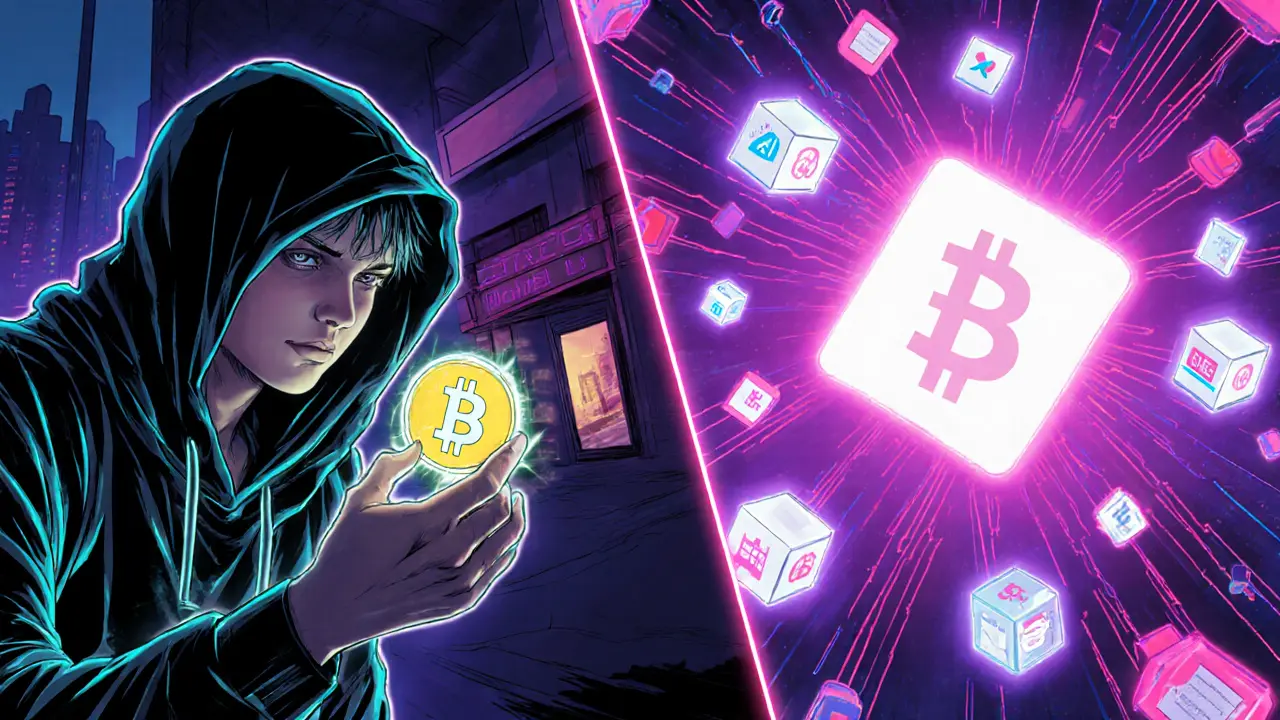Double-Spending Confirmation Calculator
This calculator helps determine the recommended number of confirmations needed to prevent double-spending based on blockchain type and transaction value. Remember: the more confirmations you wait, the safer your transaction becomes, but higher transaction volumes require more confirmations for security.
When you hear the term double spending, you’re looking at the core problem that makes digital money risky: the same token being used twice. Blockchain solves this by letting the network agree on a single history of transactions, and the way it reaches agreement-its consensus mechanism-determines how strong that protection is.
What Double Spending Really Means
Double Spending is a fraudulent attempt to transfer the same digital asset more than once. Unlike a cash note, a digital token can be copied instantly, so without a shared ledger an attacker could simply duplicate the token and spend it at two different merchants.
Why Consensus Mechanisms Matter
The consensus layer is the rulebook that tells nodes which block is the true next piece of the chain. If the rulebook is weak, an attacker can forge an alternate history and convince part of the network that a second spend is valid. Different mechanisms build that rulebook in different ways, balancing security, speed, and energy use.
Proof‑of‑Work (PoW)
Proof‑of‑Work is a consensus method where miners solve cryptographic puzzles to add blocks. Bitcoin’s PoW network runs at roughly 300 exahashes per second (July2024) and would require about $14.5billion in hardware for a 51% attack. That economic barrier makes successful double‑spending attacks on Bitcoin practically impossible when merchants wait for the standard six confirmations (≈60minutes).
- Security: Highest proven security record (15+years, >700million transactions without a confirmed double spend).
- Energy: Consumes ~110TWh annually, raising sustainability concerns.
- Finality: Six confirmations needed for practical safety.
Proof‑of‑Stake (PoS)
Proof‑of‑Stake is a consensus method where validators lock up cryptocurrency as collateral. Ethereum’s PoS requires 32ETH (~$102,400) per validator and can slash 100% of the stake for malicious behavior. Finality is reached in 12‑15minutes once 64 epochs confirm a block, but the attack threshold is roughly 66.6% of total stake.
- Security: Economic penalties replace energy costs, making attacks costly in capital.
- Energy: Cuts consumption by 99.95% compared with PoW.
- Centralization risk: Top 10 staking pools control ~32.7% of ETH (July2024).

Delegated Proof‑of‑Stake (DPoS)
Delegated Proof‑of‑Stake is a system where token holders elect a small set of block producers. EOS, for example, uses 21 elected producers, while TRON runs 27 super‑representatives. If a majority colludes, they could rewrite recent blocks and enable double spends, but the election process quickly replaces misbehaving nodes.
- Security: Fast finality (3‑5seconds on Ripple’s version) but relies on honest elected producers.
- Throughput: 2,000TPS on TRON, ideal for high‑volume payments.
- Governance: Centralization risk if a few large token holders dominate elections.
Comparing the Main Mechanisms
| Mechanism | Typical Energy Use | Attack Cost | Finality (Typical) | Key Trade‑off |
|---|---|---|---|---|
| Proof‑of‑Work (Bitcoin) | ~110TWh/yr | $14.5B hardware + $4.2M/hr electricity | 6 confirmations ≈ 60min | Highest security, high energy |
| Proof‑of‑Stake (Ethereum) | ~0.58% of PoW | Stake 32ETH (≈$102k) + possible 100% slashing | 12‑15min (64 epochs) | Energy efficient, some centralization |
| Delegated PoS (EOS / TRON) | Negligible | Control of elected producers (21‑27 nodes) | 3‑5sec | Speedy, but governance risk |
Real‑World Incidents and Lessons
Merchant anecdotes illustrate why confirmation rules matter. A Bitcoin merchant lost 0.5BTC (~$32k) after accepting a payment with only one confirmation, later reversed by a short chain reorg (June2024). Ethereum developers often mistake 15 blocks for finality, not realizing true finality needs 64 epochs-an error that can expose DeFi contracts to roll‑back attacks.
Across the ecosystem, the Crypto Loss Database records 12 exchange hacks (2020‑2023) that exploited low‑confirmation thresholds, costing $28.7M. These cases reinforce that the consensus layer alone isn’t enough; application logic must respect the right finality window.

Implementation Tips for Developers
When building a payment gateway, choose a library that exposes block confirmation data. For Bitcoin, BitcoinJS (≈40hours of dev effort) provides event hooks for "onConfirmations". For Ethereum, Web3.js or ethers.js let you query the finalized flag after the required epochs.
Key practice: always wait for the consensus‑specific finality before crediting a user’s balance. A quick checklist:
- Identify the network’s consensus type (PoW, PoS, DPoS).
- Determine the required confirmation count (e.g., 6 for Bitcoin, 64 epochs for Ethereum).
- Implement a timeout fallback if confirmations lag (e.g., alert the user).
- Log each confirmation step for audit trails.
- Test edge cases like chain reorganizations in a staging environment.
Future Directions: Hybrid and Quantum‑Resistant Consensus
Hybrid models such as Decred blend PoW and PoS, achieving a 47% better resistance to double‑spending simulations (MIT, 2024). Researchers funded by NIST are exploring post‑quantum signatures that can be dropped into existing PoS frameworks, aiming to keep double‑spending attacks infeasible even after quantum breakthroughs.
Industry forecasts (Forrester, 2024) predict that by 2027, 65% of major blockchains will adopt some hybrid approach, marrying the economic security of PoW with the efficiency of PoS. This evolution promises stronger guarantees without the energy penalty.
Key Takeaways
- Double spending is prevented by the consensus layer; the stronger the consensus, the harder the attack.
- Proof‑of‑Work offers unmatched security but burns massive energy; PoS cuts energy use dramatically while relying on economic penalties.
- Delegated PoS provides fast finality for high‑throughput use cases but introduces governance concentration risks.
- Developers must honor each network’s finality rules-mis‑configuring confirmations is a leading cause of loss.
- Hybrid and quantum‑resistant consensus designs are the next frontier for double‑spending mitigation.
Frequently Asked Questions
Can double spending happen on Bitcoin today?
Only if a merchant accepts a transaction with fewer than the recommended six confirmations. Once six blocks are added, the probability of a successful double‑spend drops to near zero.
What is the main security difference between PoW and PoS?
PoW relies on costly hardware and electricity; an attacker must control >50% of hash power. PoS relies on locked‑up capital; an attacker must own >66% of the total stake and risks losing it through slashing.
Why do DPoS systems finalize transactions in just seconds?
Because only a fixed, small group of elected producers create blocks. With fewer nodes to coordinate, consensus is reached almost instantly, but the system depends on honest elections.
How does slashing protect against double spending in PoS?
If a validator tries to sign two conflicting blocks, the protocol automatically destroys a portion-or all-of their staked assets, making the attack economically suicidal.
Will hybrid consensus eliminate double‑spending risks?
Hybrid designs reduce risk by layering defenses (e.g., PoW for finality, PoS for speed). They don’t remove the threat entirely, but they raise the cost and complexity of a successful attack.







Comments
Kyla MacLaren
October 16, 2025 AT 09:13 AMi think double spend is a big deal but most folks jus ignore it.
John Beaver
October 25, 2025 AT 15:26 PMWhen you’re building a payment gateway, it pays to check the confirmation status at the right layer. For Bitcoin, BitcoinJS lets you hook the ‘onConfirmations’ event and wait for six blocks. In Ethereum, ethers.js provides a ‘finalized’ flag after the 64‑epoch finality window. Remember to log each step so you have an audit trail if a reorg occurs. Also set a timeout so users aren’t left hanging if the network stalls. This approach keeps the double‑spend risk low without hammering the node.
Jennifer Bursey
November 3, 2025 AT 21:40 PMThe security‑throughput trade‑off in consensus is essentially a CAP‑style dilemma for decentralized ledgers. PoW offers maximal consistency at the expense of availability because of its energy footprint. PoS shifts the burden to economic finality, introducing slashing as a deterrent against equivocation. DPoS optimizes for low latency by delegating authority to a vetted set of block producers, but it also concentrates governance power. When you benchmark double‑spend resistance, you must factor in the attack surface presented by staking pools versus mining pools. Moreover, hybrid models like PoW/PoS blends inherit the strengths of both substrates while complicating the incentive alignment. In practice, developers should align their confirmation policy with the underlying consensus guarantees, otherwise they expose DeFi contracts to rollback vectors. Ultimately, the protocol choice should be guided by the risk appetite of the application’s user base.
Kevin Duffy
November 13, 2025 AT 03:53 AMGreat summary! 👍💡
Steve Cabe
November 22, 2025 AT 10:06 AMOur nation’s blockchain should stay sovereign and free from foreign interference.